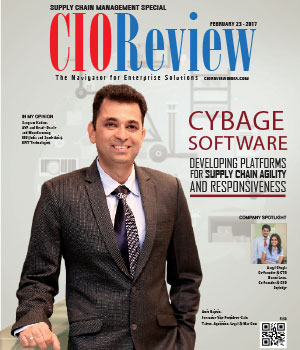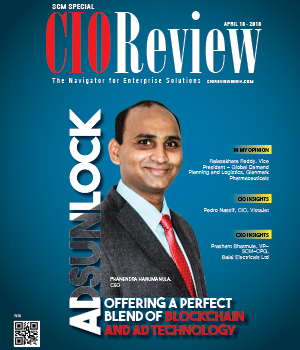
Evolution of Supply Chain Management driven by Tech Integration
Shalabh Raizada, Chief Information Officer, Stellar Value Chain Solutions

Shalabh Raizada, Chief Information Officer, Stellar Value Chain Solutions in an interaction with CIOTechOutlook, shares his thoughts on how technology adoption in Supply Chain Management is revolutionising the SCM industry.
The global SCM market size is expected to reach USD 41.7 billion by 2026. How do you see this segment developing in India? What are the key factors driving the growth?
The economy is in a recovery mode post 2 years of a very tough pandemic and the consumer sentiment is very high. Most sectors are already in the pre-COVID levels. The revival of consumer demand has intensified supply chain operations across sectors such as lifestyle, electronic appliances, consumer durables, and automotive, to name a few. E-commerce witnessed a steep growth spurt during the pandemic as online shopping was practically the only option. While people are looking at continuing online for essential or FMCG products, physical shopping for discretionary spending has also witnessed an upswing. The evolving consumer expectations and digitalized supply chain operations have also led to the emergence of time-sensitive delivery segments such as e-grocery and quick commerce. Tech integration in supply chain operations has played a crucial role in ensuring businesses are able to deliver on their consumer promise.
All in all, the supply chain management space in India is in a dynamic, multifaceted, and broad-based growth phase with an increasing network footprint across the country. Predictability, visibility, agility, resilience, and sustainability have been the overarching themes of the post-pandemic supply chain efficiency. Digital transformation was a part of the survival strategies of the supply chain management companies during the pandemic phase. Having said that, while the economy is in the recovery mode, forward-looking supply chain companies are taking tech integration to the next level by aggressively adopting artificial intelligence (AI), internet of things (IoT), machine learning (ML), big data, etc. The use of cloud computing as the mainstay of data interchanges will create the pathway for the next-gen supply chain. Moreover, the deployment of digital transformation technologies is also leading to the development of environmentally sustainable supply chain operations by bringing in energy efficiency, improved resource optimization, and efficient decision-making. As the government is focussing on logistics infrastructure development and introducing 5G technology for an enhanced data transfer bandwidth, advanced digital technologies will emerge as the key growth accelerator for supply chain management companies.
Employee and supplier aversion to change, institutional knowledge gaps, and unwillingness to turn over supply chain control to perceived “robot masters” is a common hurdle in the early going. What is your perspective in this regard? How must a CIO deal with this situation?
Change and evolution are inevitable and while the world at large is aware of it, the acceleration and adoption have seen a steep rise as it is a question of survival in this day and age. The supply chain industry was forced to take huge strides in tech adoption, thanks to the pandemic to overcome the supply and distribution challenges and comply with the restrictive measures. Nonetheless, having found the merits of tech in aiding the speed of business and savings has led to sustaining and evolution in this space. They have realized that one can no longer chart out operational and strategic outlooks without strengthening the digital backbone.
As tech adoption has become mission-critical in the digital economy, the role of a CIO has become even more dynamic. CIOs need to play a vital role in leading the development of solutions that are user-friendly, agile, visibility-enhancing, and scalable. The role of a CIO has two key aspects – facilitating a culture shift by educating the workforce and demonstrating adaptability-ease to the clients.
Silo-based procurement, inventory, and maintenance processes create conflicts among departments whose performance is measured based on isolated factors such as work order completion, units produced, on-time delivery, or cost per piece. As a result, cooperation between various factions can be challenging. With an eye toward supply chain 4.0, what should be the novel approach for performance measurement?
Supply chain 4.0 aims to boost operational efficiency and customer fulfilment with the adoption of big data analytics, robotics, IoT, etc. The core objective is to enhance visibility and discoverability in the supply chain framework to avoid any last-minute shock, delay, and disruption. The legacy systems which have run their course need to be upgraded and aligned with the new-age tech-eco-system for superior performance output. In this era of the omnichannel business model, a supply-chain mismatch could spell disaster for distribution operations. Therefore, the key performance measurement boils down to the efficiency in data interchanges. Information silos and disconnects are the root causes of sub-optimal performance and service delivery. The performance measurement metrics should identify those loopholes and set the stage for more precision-led tech adoption.
A paper titled Desafios da Supply Chain 4.0, identifies security to be one of the most daunting issues with the global supply chain network approaching supply chain 4.0. How should the security threats be tackled in the days ahead?
Data breach due to security vulnerability in the supply chain is a reality. In fact, as the pandemic has prompted supply chain management companies to switch to the movement of management systems to the cloud and hybrid work model, according to a recent Gartner report, cyber-attack on the digital supply chain has emerged as a new security threat. The most effective way to mitigate that risk is to adopt best practices and raise awareness. Eliminating the scope of human errors, deploying a stringent vendor monitoring process, and ensuring vulnerability patching are some effective ways with which security threats can be addressed.
How do you see the future of the supply chain segment in India?
In this era of an on-demand economy, the supply chain management model needs to be sustainable to consistently meet the growing demand of the consumers. Therefore, companies are looking for supply chain management services with scalability, visibility, and predictability. The evolution of the supply chain management space will be driven by tech integration which will eventually make way for enhanced resource and process optimization and end-to-end visibility. Technologies such as AI, ML, etc. will find stronger traction in this space and overall tech-adaptability will further increase, going forward.
CIO Viewpoint
Why Foolproof Facial Recognition Is Key Against...
By Joseph Sudheer Thumma, Global CEO & MD, Magellanic Cloud
National Technology Day 2025: Powering Progress...
By CIOTech Outlook Team
Aligning IT Roadmap with Business Objectives: A...
By Subhash singh Punjabi, CISO & Head Enterprise Architecture, Deepak Fertilisers & Petrochemicals Corporation Ltd
CXO Insights
Evolution of Supply Chain Management driven by...
By Shalabh Raizada, Chief Information Officer, Stellar Value Chain Solutions
Emerging Trends on Fruits & Vegetables Supply...










